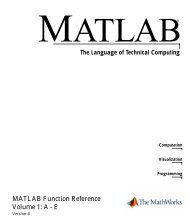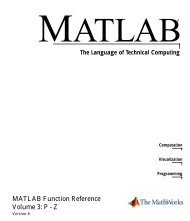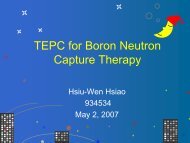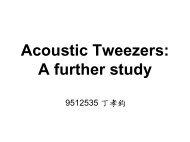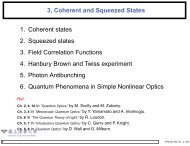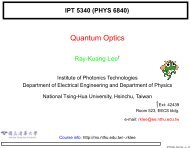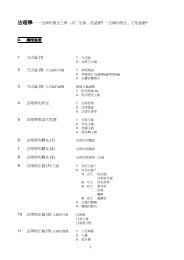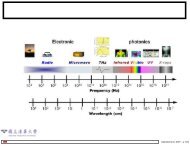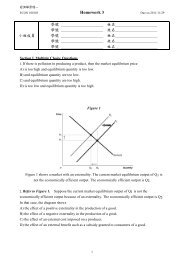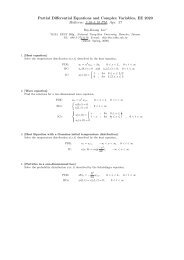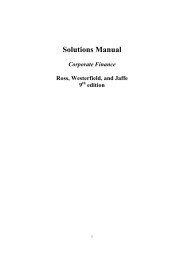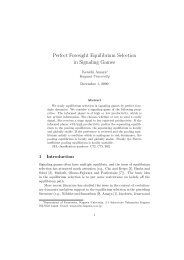7, Cavity Quantum ElectroDynamics (Cavity-QED) 1. Cavity Modes 2 ...
7, Cavity Quantum ElectroDynamics (Cavity-QED) 1. Cavity Modes 2 ...
7, Cavity Quantum ElectroDynamics (Cavity-QED) 1. Cavity Modes 2 ...
You also want an ePaper? Increase the reach of your titles
YUMPU automatically turns print PDFs into web optimized ePapers that Google loves.
7, <strong>Cavity</strong> <strong>Quantum</strong> <strong>ElectroDynamics</strong> (<strong>Cavity</strong>-<strong>QED</strong>)<br />
<strong>1.</strong> <strong>Cavity</strong> <strong>Modes</strong><br />
2. Purcell effect<br />
3. Input-Output Formulation<br />
4. Intra-cavity Atomic Systems<br />
5. Squeezed state generation<br />
Ref:<br />
Ch. 7, 13 in ”<strong>Quantum</strong> Optics,” by D. Wall and G. Milburn.<br />
Ch. 13 in ”Elements of <strong>Quantum</strong> Optics,” by P. Meystre and M. Sargent III.<br />
Ch. 10 in ”Introductory <strong>Quantum</strong> Optics,” by C. Gerry and P. Knight.<br />
Ch. 16 in ”<strong>Quantum</strong> Optics,” by M. Scully and M. Zubairy.<br />
”Theoretical Problems in <strong>Cavity</strong> Nonlinear Optics,” by P. Mandel.<br />
IPT5340, Fall ’06 – p.1/23
Purcell effect: <strong>Cavity</strong>-<strong>QED</strong> (<strong>Quantum</strong> <strong>ElectroDynamics</strong>)<br />
E. M. Purcell, Phys. Rev. 69 (1946).<br />
Nobel laureate Edward Mills Purcell (shared the prize with Felix Bloch) in 1952,<br />
for their contribution to nuclear magnetic precision measurements.<br />
from: K. J. Vahala, Nature 424, 839 (2003).<br />
IPT5340, Fall ’06 – p.2/23
Field damping by field reservoirs<br />
consider a single-mode field in a cavity with a finite leakage rate,<br />
assume the reservoir density operator is a multimode thermal field,<br />
ˆρR = <br />
k<br />
n<br />
exp(− ωkn kBT )<br />
1 − exp(− ω |n〉kk〈n|,<br />
kn<br />
) kBT the equation of motion for the reduced density operator TrR[ˆρ(t)] ≡ ˆρf(t) is,<br />
d<br />
dt ˆρf(t) = ( 1<br />
i )2<br />
t<br />
= −<br />
t<br />
t0<br />
0<br />
<br />
′<br />
dt<br />
dt ′ TrR([ ˆ HI(t),[ ˆ HI(t ′ ), ˆρf(t) ⊗ ˆρR(0)]]),<br />
k<br />
g 2 k {nth[ââ † ˆρf(t ′ ) − â † ˆρf(t ′ )â]e −i(ω−ω k)(t−t ′ )<br />
+(nth + 1)[â † âˆρf(t ′ ) − âˆρf(t ′ )â † ])e i(ω−ω k)(t−t ′ ) } + H. C,<br />
IPT5340, Fall ’06 – p.3/23
Field damping by field reservoirs<br />
the equation of motion for the reduced density operator TrR[ˆρ(t)] ≡ ˆρf(t) is,<br />
d<br />
dt ˆρf(t)<br />
t <br />
′<br />
= − dt g<br />
t0 k<br />
2 k {nth[ââ † ˆρf(t ′ ) − â † ˆρf(t ′ )â]e −i(ω−ωk)(t−t ′ )<br />
+(nth + 1)[â † âˆρf(t ′ ) − âˆρf(t ′ )â † ])e i(ω−ω k)(t−t ′ ) } + H. C,<br />
again, by replacing sumkg 2 k with the integral dωkD(ωk)g(ωk) 2 , and<br />
t<br />
t0<br />
<br />
′<br />
dt<br />
k<br />
g 2 k e±i(ω−ω k)(t−t ′ ) =<br />
≈<br />
t<br />
<br />
t0<br />
dt ′<br />
<br />
dωkD(ωk)g(ωk) 2 e ±i(ω−ω k)(t−t ′ ) ,<br />
dωkD(ωk)g(ωk) 2 πδ(ω − ωk),<br />
≈ πD(ω)g(ω) 2 ≡ 1 ω<br />
( ),<br />
2 Qe<br />
where ω/Qe is the cavity photon decay rate due to leakage (output coupling) via a<br />
partially reflecting mirror,<br />
IPT5340, Fall ’06 – p.4/23
Field damping by field reservoirs<br />
the equation of motion for the reduced density operator TrR[ˆρ(t)] ≡ ˆρf(t) is,<br />
d<br />
dt ˆρf(t) = − 1 ω<br />
( ){nth[ââ<br />
2 Qe<br />
† ˆρf(t ′ ) − â † ˆρf(t ′ )â] + (nth + 1)[â † âˆρf(t ′ ) − âˆρf(t ′ )â †<br />
+H. C,<br />
compared to the case of atom damping by field reservoirs,<br />
d<br />
dt ˆρa(t) = − 1<br />
2 Γ{nth[ˆσ−ˆσ+ˆρa − ˆσ+ˆρaˆσ−] + (nth + 1)[ˆσ+ˆσ−ˆρa − ˆσ−ˆρaˆσ+])} + H<br />
IPT5340, Fall ’06 – p.5/23
Input-output formulation of optical cavity<br />
in preceding chapters, we have used a master equation to calculate the photon<br />
statistics inside an optical cavity when the internal field is damped,<br />
in this approach, the field external to the cavity is treated as a heat bath, reservoir,<br />
the heat bath is simply a passive system with which the system gradually comes<br />
into equilibrium,<br />
now we would explicitly treat the heat bath as the external field, and determine the<br />
effect of the intra-cavity dynamics on the quantum statistics of the output field,<br />
IPT5340, Fall ’06 – p.6/23
<strong>Cavity</strong> modes<br />
consider a single cavity mode interacting with an external field,<br />
the interaction Hamiltonian is<br />
<br />
ˆHI = i<br />
dωg(ω)[ ˆ b(ω)â † − â ˆ b † (ω)],<br />
where â is the annihilation operator for the intra-cavity field, with the commutation<br />
relations,<br />
[â, â † ] = 1,<br />
where ˆ b(ω) are the annihilation operators for the external field, with<br />
[ ˆ b(ω), ˆ b † (ω ′ )] = δ(ω − ω ′ ),<br />
in actual fact the physical frequency limits are (0, ∞),<br />
however, for high frequency optical systems we may shift the integration to a<br />
frequency ω0, the cavity resonance frequency,<br />
the integration limits are (−ω0, ∞), as ω0 is large, then we approximate ∞<br />
−∞ ,<br />
IPT5340, Fall ’06 – p.7/23
Input-output theory<br />
the Heisenberg equation of motion for ˆ b(ω) is<br />
d<br />
ˆb(ω) = −iωˆb(ω) + g(ω)â,<br />
dt<br />
with the initial condition at time t0 < t, the input,<br />
ˆ b(ω) = e −iω(t−t0)ˆ b0(ω) + g(ω)<br />
where t0 < t and ˆ b0(ω) is the value of ˆ b(ω) at t = t0,<br />
or with the final condition at time t1 > t, the output,<br />
ˆ b(ω) = e −iω(t−t1)ˆ b1(ω) − g(ω)<br />
t<br />
dt ′ e −iω(t−t′ ) ′<br />
â(t ),<br />
t0<br />
t1<br />
where t < t1 and ˆ b1(ω) is the value of ˆ b(ω) at t = t1,<br />
t<br />
dt ′ e −iω(t−t′ ) â(t ′ ),<br />
IPT5340, Fall ’06 – p.8/23
Input-output theory<br />
the system operator obeys the equation,<br />
d<br />
dt<br />
i<br />
â = −<br />
[â, ∞<br />
ˆHS] − dωg(ω)<br />
−∞<br />
ˆb(ω), in terms of the solutions with initial condition,<br />
then<br />
d<br />
dt<br />
ˆ b(ω) = e −iω(t−t0)ˆ b0(ω) + g(ω)<br />
t<br />
dt ′ e −iω(t−t′ ) ′<br />
â(t ),<br />
i<br />
â = −<br />
[â, ˆ ∞<br />
HS] − dωg(ω)e<br />
−∞<br />
−iω(t−t0)ˆ<br />
∞<br />
b0(ω) − dωg<br />
−∞<br />
2 t<br />
(ω) dt<br />
t0<br />
′ e −iω(t−t′ )<br />
â(t<br />
define an input field,<br />
âIN(t) = −1<br />
√ 2π<br />
∞<br />
−∞<br />
t0<br />
dωe −iω(t−t0)ˆ b0(ω),<br />
IPT5340, Fall ’06 – p.9/23
Input-output theory<br />
the system operator obeys the equation,<br />
d<br />
dt<br />
i<br />
â = −<br />
[â, ˆ ∞<br />
HS] − dωg(ω)e<br />
−∞<br />
−iω(t−t0)ˆ<br />
∞<br />
b0(ω) − dωg<br />
−∞<br />
2 t<br />
(ω) dt<br />
t0<br />
′ e −iω(t−t′ )<br />
â(t<br />
define an input field, âI(t) = −1<br />
√ 2π<br />
commutation relation, [âI(t), â †<br />
I (t′ )] = δ(t − t ′ ),<br />
with Markovian approximation,<br />
∞<br />
−∞<br />
dωg 2 (ω)<br />
∞<br />
−∞ dωe−iω(t−t0)ˆ b0(ω), which satisfy the<br />
t<br />
dt<br />
t0<br />
′ e −iω(t−t′ ) ′<br />
â(t ) ≈<br />
∞ t<br />
2<br />
g (ω) dω dt<br />
−∞ t0<br />
′ e −iω(t−t′ ) ′<br />
â(t ),<br />
=<br />
γ<br />
2π 2π<br />
t<br />
dt ′ δ(t − t ′ )â(t ′ ) = γ<br />
2 a(t),<br />
where we use following result,<br />
t<br />
dt ′ δ(t − t ′ )f(t ′ ) =<br />
t0<br />
t1<br />
t<br />
t0<br />
dt ′ δ(t − t ′ )f(t ′ ) 1<br />
2 f(t), (t0 < t < t1),<br />
IPT5340, Fall ’06 – p.10/23
d<br />
dt<br />
Input-output theory<br />
the system operator obeys the equation,<br />
i<br />
â = −<br />
[â, ˆ ∞<br />
HS] − dωg(ω)e<br />
−∞<br />
−iω(t−t0)ˆ<br />
∞<br />
b0(ω) − dωg<br />
−∞<br />
2 t<br />
(ω) dt<br />
t0<br />
′ e −iω(t−t′ )<br />
â(t<br />
= − i<br />
[â, ˆ HS] − γ<br />
2 â(t) + √ γâI(t),<br />
this is a Langevin equation for the damped amplitude â(t) but with the noise term<br />
appears explicitly as the input field,<br />
the time reverse Langevin equation is<br />
where<br />
d<br />
dt<br />
â = − i<br />
[â, ˆ HS] + γ<br />
2 â(t) − √ γâO(t),<br />
âO(t) = 1<br />
√ 2π<br />
∞<br />
−∞<br />
dωe −iω(t−t1)ˆ b1(ω),<br />
IPT5340, Fall ’06 – p.11/23
Input-output theory<br />
the system operator obeys the equation,<br />
d<br />
dt<br />
â = − i<br />
[â, ˆHS] − γ<br />
2 â(t) + √ γâI(t),<br />
= − i<br />
[â, ˆ HS] + γ<br />
2 â(t) − √ γâO(t),<br />
the relation between the external field and the intra-cavity field may be obtained,<br />
âO(t) + âI(t) = √ γâ(t),<br />
which is a boundary condition relating each of the far-field amplitudes outside the<br />
cavity to the internal cavity field,<br />
it is easy to see that interference between the input and the cavity field may<br />
contribute to the observed output field,<br />
IPT5340, Fall ’06 – p.12/23
for a linear system<br />
where<br />
a(t) =<br />
d<br />
dt<br />
⎛<br />
Linear system<br />
a(t) = Aa − γ<br />
2 â(t) + √ γaI(t),<br />
⎝ â(t)<br />
â † (t)<br />
⎞<br />
⎠ , and aI(t) =<br />
define the Fourier components of the intra-cavity field,<br />
a(ω) =<br />
⎛<br />
⎝ â(ω)<br />
â † (ω)<br />
⎞<br />
⎠ , where â(t) = 1<br />
√ 2π<br />
⎛<br />
⎝ âI(t)<br />
â †<br />
I (t)<br />
then the equation of motion in frequency domain becomes,<br />
by the same way,<br />
[A + (iω − γ<br />
2 )1]a(ω) = −√ γaI(ω),<br />
[A + (iω + γ<br />
2 )1]a(ω) = +√ γaO(ω),<br />
<br />
⎞<br />
⎠ ,<br />
dωe −iω(t−t0) â(ω),<br />
IPT5340, Fall ’06 – p.13/23
for a linear system<br />
or<br />
Linear system<br />
[A + (iω − γ<br />
2 )1]a(ω) = −√ γaI(ω),<br />
[A + (iω + γ<br />
2 )1]a(ω) = +√ γaO(ω),<br />
aO(ω) = −[A + (iω + γ<br />
γ<br />
)1][A + (iω −<br />
2 2 )1]−1aI(ω), for example, consider an empty one-sided cavity,<br />
in this case the only source of loss in the cavity is through the mirror which couples<br />
the input and output fields,<br />
the system Hamiltonian is ˆ HS = ω0â † â, and<br />
A =<br />
⎛<br />
⎝ −iω0 0<br />
0 iω0<br />
⎞<br />
⎠ ,<br />
IPT5340, Fall ’06 – p.14/23
Linear system<br />
for example, consider an empty one-sided cavity,<br />
in this case the only source of loss in the cavity is through the mirror which couples<br />
the input and output fields,<br />
the system Hamiltonian is ˆ HS = ω0â † â, and<br />
then<br />
A =<br />
aO(ω) =<br />
⎛<br />
⎝ −iω0 0<br />
0 iω0<br />
⎞<br />
⎠ ,<br />
γ/2 + i(ω − ω0)<br />
γ/2 − i(ω − ω0) aI(ω),<br />
there is a frequency dependent phase shift between the output and input,<br />
the relationship between the input and the internal field is,<br />
a(ω) =<br />
√ γ<br />
γ/2 − i(ω − ω0) aI(ω),<br />
which leads to a Lorentzian of width γ/2 for the intensity transmission function,<br />
IPT5340, Fall ’06 – p.15/23
Two-sided cavity<br />
a two-sided cavity has two partially transparent mirrors with associated loss<br />
coefficients γ1 and γ2,<br />
in this case there are two input ports and two output ports,<br />
the equation of motion for the internal field is<br />
d<br />
dt â(t) = −iω0â(t) − 1<br />
2 (γ1 + γ2)â(t) + √ γ1âI(t) + √ γ2 ˆbI(t), the relationship between the internal and input field frequency components for an<br />
empty cavity is then<br />
√<br />
γ1aI(ω) +<br />
a(ω) =<br />
√ γ2bI(ω)<br />
,<br />
− i(ω − ω0)<br />
γ1+γ2<br />
2<br />
IPT5340, Fall ’06 – p.16/23
Two-time correlation function<br />
two boundary conditions of the reservoir,<br />
ˆ b(ω) = e −iω(t−t0)ˆ b0(ω) + g(ω)<br />
ˆ b(ω) = e −iω(t−t1)ˆ b1(ω) − g(ω)<br />
the input and output fields,<br />
or<br />
âIN(t) = −1<br />
√ 2π<br />
âOUT (t) = 1<br />
√ 2π<br />
t<br />
dt ′ e −iω(t−t′ ) ′<br />
â(t ), at time t0 < t, the input,<br />
t0<br />
t1<br />
t<br />
∞<br />
−∞<br />
∞<br />
dt ′ e −iω(t−t′ ) â(t ′ ), at time t1 > t, the output,<br />
−∞<br />
√ <br />
γ 1<br />
âIN(t) = â(t) − √<br />
2 2π<br />
√<br />
γ 1<br />
âOUT (t) = â(t) + √<br />
2 2π<br />
dωe −iω(t−t0)ˆ b0(ω),<br />
dωe −iω(t−t1)ˆ b1(ω),<br />
<br />
dω ˆ b(ω, t),<br />
dω ˆ b(ω, t),<br />
IPT5340, Fall ’06 – p.17/23
Two-time correlation function<br />
the input and output fields,<br />
let ĉ(t) be any system operator, then<br />
with<br />
√ <br />
γ 1<br />
âIN(t) = â(t) − √<br />
2 2π<br />
√<br />
γ 1<br />
âOUT (t) = â(t) + √<br />
2 2π<br />
<br />
dω ˆ b(ω, t),<br />
dω ˆ b(ω, t),<br />
[ĉ(t), √ γâIN(t ′ )] = γ<br />
2 [ĉ(t), â(t′ )], for t = t ′ ,<br />
[ĉ(t), √ γâIN(t ′ )] = 0, for t ′ > t,<br />
[ĉ(t), √ γâOUT (t ′ )] = 0, for t ′ < t,<br />
[ĉ(t), √ γâIN(t ′ )] = γ[ĉ(t), â(t ′ )], for t ′ < t,<br />
âO(t) + âI(t) = √ γâ(t),<br />
IPT5340, Fall ’06 – p.18/23
Two-time correlation function<br />
let ĉ(t) be any system operator, then<br />
with<br />
[ĉ(t), √ γâIN(t ′ )] = γ<br />
2 [ĉ(t), â(t′ )], for t = t ′ ,<br />
[ĉ(t), √ γâIN(t ′ )] = 0, for t ′ > t,<br />
[ĉ(t), √ γâIN(t ′ )] = γ[ĉ(t), â(t ′ )], for t ′ < t,<br />
the commutator for the output field is<br />
âO(t) + âI(t) = √ γâ(t),<br />
[âO(t), â †<br />
O (t′ )] = [âI(t), â †<br />
I (t′ )],<br />
IPT5340, Fall ’06 – p.19/23
Spectrum of squeezing for the parametric oscillator<br />
below the threshold, the Hamiltonian for a parametric oscillator is<br />
then<br />
where<br />
ˆHS = ω0â † â + i<br />
2 (ǫâ†2 − ǫ ∗ â 2 ),<br />
[A + (iω − γ<br />
2 )1]a(ω) = −√ γaI(ω),<br />
[A + (iω + γ<br />
2 )1]a(ω) = +√ γaO(ω),<br />
A =<br />
⎛<br />
⎝ −iω0 ǫ<br />
ǫ∗ iω0<br />
the Fourier components for the output field is<br />
âO(ω) =<br />
1<br />
( γ<br />
2 − i(ω − ω0) 2 {[(γ<br />
− |ǫ| 2 2 )2 + (ω − ω0) 2 + |ǫ| 2 ]âI(ω) + ǫγâ †<br />
⎞<br />
⎠ ,<br />
I (−ω)},<br />
IPT5340, Fall ’06 – p.20/23
<strong>Quantum</strong> State Transfer as a <strong>Quantum</strong> Repeater<br />
J. I. Cirac, P. Zoller, H. J. Kimble, and H. Mabuchi, Phys. Rev. Lett. 78, 3221 (1997).<br />
IPT5340, Fall ’06 – p.21/23
<strong>Quantum</strong> State Transfer as a <strong>Quantum</strong> Repeater<br />
the Hamiltonian describing the interaction of each atom with the corresponding<br />
cavity mode is ( = 1),<br />
ˆHi = ωâ †<br />
1<br />
iâi+ω0|r〉ii〈r|+g(|r〉ii〈g|âi+h.c)+ 2 Ωi(t)[e −i(ωLt+φi) |r〉ii〈e|+h. c.], (i = 1<br />
in a quantum stochastic description employing the input¡Voutput formalism the<br />
cavity mode operators obey the quantum Langevin equations,<br />
d<br />
dt âi = − i<br />
[âi, ˆ Hi] − κâi(t) − √ 2κâ (i)<br />
I (t), (i = 1, 2),<br />
the output of each cavity is given by the equation,<br />
â (i)<br />
O (t) = â(i)<br />
I (t) + √ 2κâi(t),<br />
IPT5340, Fall ’06 – p.22/23
<strong>Quantum</strong> State Transfer as a <strong>Quantum</strong> Repeater<br />
The output field of the first cavity constitutes the input for the second cavity with an<br />
appropriate time delay, i.e., â (2)<br />
(t − τ),<br />
I (t) = â (1)<br />
O<br />
The output field of the second cavity is<br />
then<br />
â (2)<br />
O (t) = â(1)<br />
I (t − τ) + √ 2κ[â1(t − τ) + â2(t)],<br />
d<br />
dt â1 = − i<br />
[â1, ˆ H1] − κâ1(t) − √ 2κâ (1)<br />
I (t),<br />
d<br />
dt â2 = − i<br />
[â2, ˆ H2] − κâ2(t) − 2κâ1(t − τ) − √ 2κâ (1)<br />
I (t − τ),<br />
IPT5340, Fall ’06 – p.23/23



